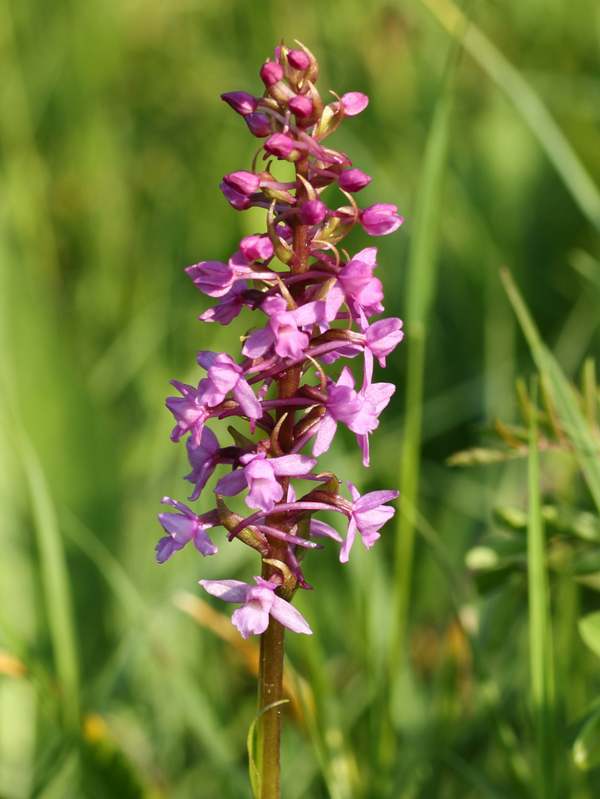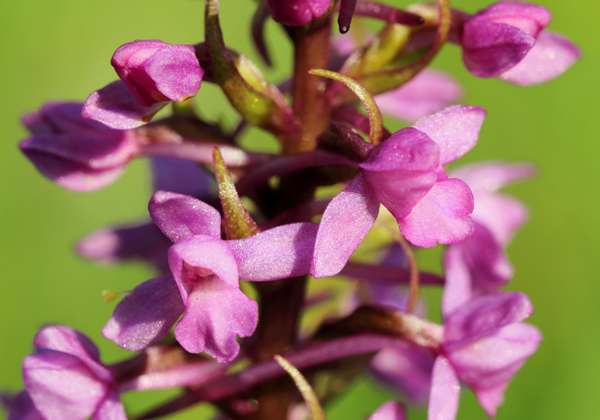Trees Birds Mammals Fish Amphibians Reptiles
Wild Algarve
Bookshop
Gymnadenia conopsea var. borealis - Heath Fragrant-orchid
Phylum: Magnoliophyta - Class: Liliopsida - Order: Orchidales - Family: Orchidaceae

The Fragrant-orchids have been the subject of much molecular study in recent years, and as a result of differences revealed between them, the three British-growing varieties currently recognised as varieties of Gymnadenia conopsea and frequently called Gymnadenia conopsea (Chalk Fragrant-0rchid), Gymnadenia borealis (Heath Fragrant-orchid) and Gymnadenia densiflora (Marsh Fragrant-orchid) are now designated as three distinct species. The third of these types, Marsh Fragrant-orchid, grows in alkaline marshy ground and is therefore more easily distinguishable by habitat if not by obvious morphological differences. The remaining types, Chalk Fragrant-orchid and Heath Fragrant-orchid are more difficult to tell apart.
Description
The Heath Fragrant-orchid only grows to a maximum of 30cm making it the shortest of the three varieties of fragrant orchids to appear in Britain. It has 3-5 narrow leaves at the base of the stem which are deeply folded and pointed. The small, lax inflorescence which carries up to 30 dark pink flowers also sets it apart from Marsh Fragrant Orchid and Common Fragrant-orchid which have much more robust flower spikes carrying many more flowers.
Distribution
The three fragrant orchids that grow in Britain are so frequently confused with each other that it is very difficult to determine their range with any confidence. However, Heath Fragrant-orchid is recorded from many parts of England and Wales, from Cornwall in the south to the Scottish islands in the north. In other parts of the world the picture is even more confused because there is an additional plant called Gymnadenia odoratissima which is accorded species status to add to the equation. Heath Fragrant-orchid is recorded in France.

Habitat
Gymnadenia conopsea var.borealis grows in unimproved grasslands, sand dune systems and grassy moorland. It is tolerant of some degree of acidity..
Flowering times
This orchid flowers from late June to August.
Varieties and Hybrids
Hybrids
Britain's three species of Fragrant-orchids may hybridise, but confirmation of this is difficult.
Intergeneric Hybrids
There are several intergenetic hybrids recorded:
A hybrid with the Small White-orchid Pseudorchis albida has been recorded in Yorkshire and Scotland but has no formal name.
A hybrid with Early Marsh-orchid Dactylorhiza incarnata found in Cornwall has no formal name.
X Dactylodenia varia is a hybrid with Northern Marsh-orchid Dactylorhiza purpurella,
X Dactylodenia st-quintinii is a hybrid with Common Spotted-orchid Dactylorhiza fuchsii
X Dactylodenia evansii is a hybrid with Heath Spotted-orchid Dactylorhiza maculata
Etymology
The genus name Gymnadenia means 'naked gland' and refers to the characteristics of the flower spur within which nectar is secreted. The specific epithet borealis means 'from or of the north'.
Reference sources
The Plant List
Sue Parker (2023) Wild Orchids of Wales - how, when and where to find them; First Nature e-book (Amazon Kindle format)
Anne and Simon Harrap (2005) Orchids of Britain and Ireland; A&C Black
Pierre Delforge (2005) Orchids of Europe, North Africa and the Middle East; A&C Black
Sue Parker's latest ebook is a revised and enlarged edition of Wild Orchids in The Burren. Full details here...
Buy it for just £5.95 on Amazon...
Sue Parker's new ebook is a comprehensive and fully revised edition of her acclaimed field guide to the Wild Orchids of Wales. Full details here...
Buy it for just £5.95 on Amazon...
Sue Parker's 5-star acclaimed field guide to the Wild Orchids of the Algarve is now available as an ebook. Full details here...
Buy it for just £5.95 on Amazon...
Please Help Us: If you have found this information interesting and useful, please consider helping to keep First Nature online by making a small donation towards the web hosting and internet costs.
Any donations over and above the essential running costs will help support the conservation work of Plantlife, the Rivers Trust and charitable botanic gardens - as do author royalties and publisher proceeds from books by Pat and Sue.